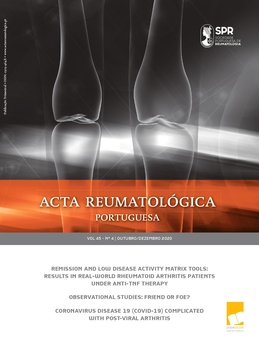Septic arthritis: a 5-year review of admissions to the Orthopedic Department
Authors
Joana Ramos Rodrigues; Cristina Varino Sousa; Joana Silva; Soraia Azevedo; Francisca Guimarães; Diogo Esperança Almeida; Hugo Parente; Daniela Santos Faria; José Tavares Costa;
Objectives: Characterization of sociodemographic and clinical aspects of patients admitted to the Orthopedic Department (OD) after observation in the Emergency Room (ER) with the diagnosis of septic arthritis (SA).
Material and Methods: A retrospective, monocentric, cross-sectional study was conducted. Sociodemographic and clinical data on patients admitted to the OD with suspected SA between April 2014 and September 2019 were collected.
Results: One-hundred and ten patients were included. In the overall sample, most patients were male (n=61; 55.5%) with a median age of 70 (IQR=20) years old. Thirty-six patients (32.7%) had a previous history of hyperuricemia or gout, or had this diagnosis established at the time of their hospital admission. Monoarthritis was the most common form of presentation (n=106; 96.4%), with the knee being the most frequently involved joint (n=60; 54.5%). S. aureus was the most representative microorganism in synovial fluid (SF) cultures (n=33; 30.6%). SF cultures did not allow the identification of a causative microorganism in 53 cases submitted to arthrotomy (50.5%). Serum C-reactive protein (CRP) was a predictive factor for microorganism identification in SF cultures, with values ≥ 17.6 mg/dl presenting a sensibility and specificity of 60.8% and 77.4%, respectively [CI 95% (0.52 – 0.80)]. Patients with a diagnosis of hyperuricemia or gout presented a higher risk for a negative SF culture result (OR = 4.7 [CI 95% =1.9 - 11.5]).
Conclusions: Elderly subjects with multiple comorbidities, namely cardiovascular risk factors, seem more prone to SA. Serum CRP appears to be a predictive factor for the identification of a causative microorganism. The higher risk of a negative SF culture in patients with hyperuricemia or gout should alert us for the possibility of misdiagnosis of SA in patients with an acute gout attack.
Joana Ramos Rodrigues
ULSAM
Cristina Varino Sousa
ULSAM
Joana Silva
ULSAM
Soraia Azevedo
ULSAM
Francisca Guimarães
ULSAM
Diogo Esperança Almeida
ULSAM
Hugo Parente
ULSAM
Daniela Santos Faria
ULSAM
José Tavares Costa
ULSAM
ULSAM
Cristina Varino Sousa
ULSAM
Joana Silva
ULSAM
Soraia Azevedo
ULSAM
Francisca Guimarães
ULSAM
Diogo Esperança Almeida
ULSAM
Hugo Parente
ULSAM
Daniela Santos Faria
ULSAM
José Tavares Costa
ULSAM





